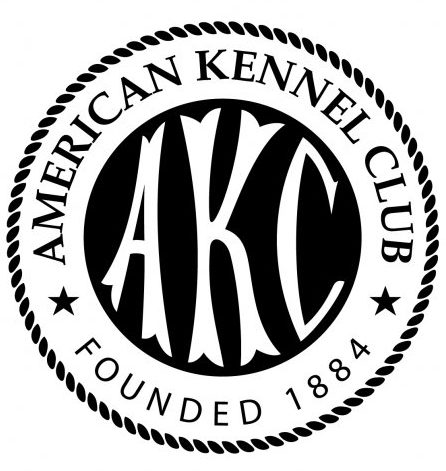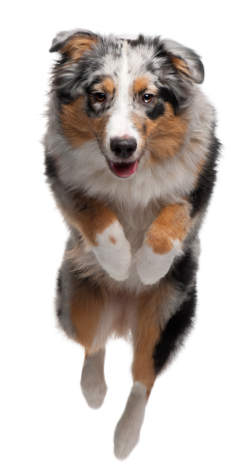The Aussie, as it is known, is a medium-sized, robust, well-balanced, rustic dog. The ears are set high at the side of the head, triangular and slightly rounded at the tip. The coat is of medium texture, straight to slightly wavy, weather resistant, of moderate length with an undercoat. The quantity of undercoat varies with climate. Hair is short and smooth on the head, outside of the ears, front of the forelegs and below the hocks. Backs of the forelegs are moderately feathered; breeches are moderately full. There is a moderate mane and frill, which is more pronounced in male dogs than females. The Aussie has a natural or docked bobtail and is straight. The AKC standard states the tail should not exceed four inches in length. Tails that are longer are docked. The dog’s body should be slightly longer than its height at the withers. The chest is not broad but is deep with the lowest point reaching the elbow. The front legs are straight, perpendicular to the ground. The feet are oval, compact with close knit, well arched toes. The front dewclaws are sometimes removed, but back dewclaws are almost always removed. The overall size of the head should be in proportion to the body, with the muzzle being equal or slightly shorter than the back skull. The stop is moderate to well-defined. The teeth should form a scissors or level bite. The eyes are oval in shape and medium in size. Eye colors include brown, blue, amber or any variation or combination including flecks and marbling. The ears are set high on the head, triangular in shape and slightly rounded at the tip. When the dog is at full attention the ears break forward and over, or to the side as a rose ear. Coat colors include blue merle, black, red merle (liver), solid red with or without white markings and/or tan (copper) points, with no order of preference. The coat is medium texture, straight to wavy, weather resistant and of medium length. There should be feathering on the back of the legs, the mane and frill around the neck.
Is an Aussie The RIGHT breed for you?
Australian Shepherds are easy-going, remaining puppy-like even in their adult years. This courageous dog makes a good watchdog for the home. Aussies are excellent with children, even with an active child, as they love to play. A devoted, loyal friend and guardian, for they are naturally protective. Affectionate, very lively, agile and attentive – they are eager to please, with a sixth sense about what the owner wants. Australian Shepherds are highly intelligent and easy to train. Though aggressive when at work with livestock, the Aussie is gentle with human friends. Australian Shepherds are not the kind of dog to lay around the living room all day or live happily in the backyard with only a 15 minute walk. They need much more exercise than that and something to occupy their mind daily or they will become bored, leading to serious behavior problems. Without enough mental and physical exercise and or a lack of a true pack leader, they can become nervous and destructive if left alone. Socialize well to prevent them from becoming suspicious of strangers. Working lines may be too energetic for people who only have a moderately active lifestyle. Some like to nip people’s heels in an attempt to herd them, and this behavior needs to be corrected teaching the dog that humans are not to be herded. The Aussie is a quiet worker. This breed is not usually dog aggressive.
Height, Weight
Height: Males 20-23 inches (52-58cm.) Females 18-21 inches (46-53cm.)
Weight: Males 50-65 pounds (25-29 kg) Females 40-55 pounds (18-25 kg.)
Australian Shepherd Breed Standards

Aussie General Appearance
The Australian Shepherd is an intelligent working dog of strong herding and guarding instincts. He is a loyal companion and has the stamina to work all day. He is well balanced, slightly longer than tall, of medium size and bone, with coloring that offers variety and individuality. He is attentive and animated, lithe and agile, solid and muscular without cloddiness. He has a coat of moderate length and coarseness. He has a docked or natural bobbed tail. Size, Proportion, Substance Size–The preferred height for males is 20-23 inches, females 18-21 inches. Quality is not to be sacrificed in favor of size. Proportion–Measuring from the breastbone to rear of thigh and from top of the withers to the ground the Australian Shepherd is slightly longer than tall. Substance–Solidly built with moderate bone. Structure in the male reflects masculinity without coarseness. Bitches appear feminine without being slight of bone.

Head
The Head is clean cut, strong and dry. Overall size should be in proportion to the body. The muzzle is equal in length or slightly shorter than the back skull. Viewed from the side the topline of the back skull and muzzle form parallel planes, divided by a moderate, well-defined stop. The muzzle tapers little from base to nose and is rounded at the tip. Expression –Showing attentiveness and intelligence, alert and eager. Gaze should be keen but friendly. Eyes are brown, blue, amber or any variation or combination thereof, including flecks and marbling. Almond shaped, not protruding nor sunken. The blue merles and blacks have black pigmentation on eye rims. The red merles and reds have liver (brown) pigmentation on eye rims. Ears are triangular, of moderate size and leather, set high on the head. At full attention they break forward and over, or to the side as a rose ear. Prick ears and hanging ears are severe faults. Skull Top flat to slightly domed. It may show a slight occipital protuberance. Length and width are equal. Moderate well-defined stop. Muzzle tapers little from base to nose and is rounded at the tip. Nose–Blue merles and blacks have black pigmentation on the nose (and lips). Red merles and reds have liver (brown) pigmentation on the nose (and lips). On the merles it is permissible to have small pink spots; however, they should not exceed 25% of the nose on dogs over one year of age, which is a serious fault. Teeth–A full complement of strong white teeth should meet in a scissors bite or may meet in a level bite. Disqualifications–Undershot. Overshot greater than 1/8 inch. Loss of contact caused by short center incisors in an otherwise correct bite shall not be judged undershot. Teeth broken or missing by accident shall not be penalized.
Neck, Topline, Body
Neck is strong, of moderate length, slightly arched at the crest, fitting well into the shoulders. Topline–Back is straight and strong, level and firm from withers to hip joints. The croup is moderately sloped. Chest is not broad but is deep with the lowest point reaching the elbow. The ribs are well sprung and long, neither barrel chested nor slab-sided. The underline shows a moderate tuck-up. Tail is straight, docked or naturally bobbed, not to exceed four inches in length.
Forequarters
Shoulders–Shoulder blades are long, flat, fairly close set at the withers and well laid back. The upper arm, which should be relatively the same length as the shoulder blade, attaches at an approximate right angle to the shoulder line with forelegs dropping straight, perpendicular to the ground. Legs straight and strong. Bone is strong, oval rather than round. Pastern is medium length and very slightly sloped. Front dewclaws may be removed. Feet are oval, compact with close knit, well arched toes. Pads are thick and resilient.
Hindquarters
The width of the hindquarters is equal to the width of the forequarters at the shoulders. The angulation of the pelvis and upper thigh corresponds to the angulation of the shoulder blade and upper arm, forming an approximate right angle. Stifles are clearly defined, hock joints moderately bent. The hocks are short, perpendicular to the ground and parallel to each other when viewed from the rear. Rear dewclaws must be removed. Feet are oval, compact with close knit, well arched toes. Pads are thick and resilient.
Coat
Hair is of medium texture, straight to wavy, weather resistant and of medium length. The undercoat varies in quantity with variations in climate. Hair is short and smooth on the head, ears, front of forelegs and below the hocks. Backs of forelegs and britches are moderately feathered. There is a moderate mane and frill, more pronounced in dogs than in bitches. Non-typical coats are severe faults.
Color
Blue merle, black, red merle, red-all with or without white markings and/or tan (copper) points, with no order of preference. The hairline of a white collar does not exceed the point of the withers at the skin. White is acceptable on the neck (either in part or as a full collar), chest, legs, muzzle underparts, blaze on head and white extension from underpart up to four inches, measuring from a horizontal line at the elbow. White on the head should not predominate, and the eyes must be fully surrounded by color and pigment. Merles characteristically become darker with increasing age. Disqualifications White body splashes, which means white on body between withers and tail, on sides between elbows and back of hindquarters in all colors.
Gait
The Australian Shepherd has a smooth, free and easy gait. He exhibits great agility of movement with a well-balanced, ground covering stride. Fore and hind legs move straight and parallel with the center line of the body. As speed increases, the feet (front and rear) converge toward the center line of gravity of the dog while the back remains firm and level. The Australian Shepherd must be agile and able to change direction or alter gait instantly. Temperament The Australian Shepherd is an intelligent, active dog with an even disposition; he is good natured, seldom quarrelsome. He may be somewhat reserved in initial meetings. Faults Any display of shyness, fear or aggression is to be severely penalized.
Health Problems
The gene for the beautiful merle coloration also carries a blind/deaf factor. This may be expressed only in merle/merle crosses. Be sure to check the hearing on merle puppies. Natural bobtail-to-natural bobtail breedings can result in some offspring with serious spinal defects. Major concerns: cataract, CEA. Minor concerns: CHD, nasal solar dermatitis, Pelger – Huet syndrome, iris coloboma. Occasionally seen: lumbar sacral syndrome, epilepsy, PRA, vWD, distichiasis, PDA, PPM. Suggested tests: hip, eye. Some are prone to hip dysplasia This breed is often sensitive to ivermectin; however, the dosage for heartworm preventive is considered safe. Also IMHA (Immune Mediated Hemolytic Anemia. Some herding dogs carry a MDR1 gene which makes them sensitive to certain drugs, that are otherwise okay to give another dog, but if tested positive for this gene can kill them.
Living Conditions
This breed is not recommended for apartment life. They are moderately active indoors and will do best with at least a large yard.
Exercise
This energetic working dog needs plenty of vigorous exercise to stay in shape, mentally and physically, or better yet, some real work to do. Very intelligent and crave a good challenge. They need to be taken on a daily, brisk, long walk, jog or run alongside you when you bicycle. If under-exercised, this breed can become restless and destructive.
Life Expectancy
About 12-15 years
Litter Size
6 – 9 puppies – Average 7 Grooming The coat is easy to groom and needs little attention. Brush occasionally with a firm bristle brush and bathe only when necessary. This breed is an average shedder.
Source: AKC.org 2012
